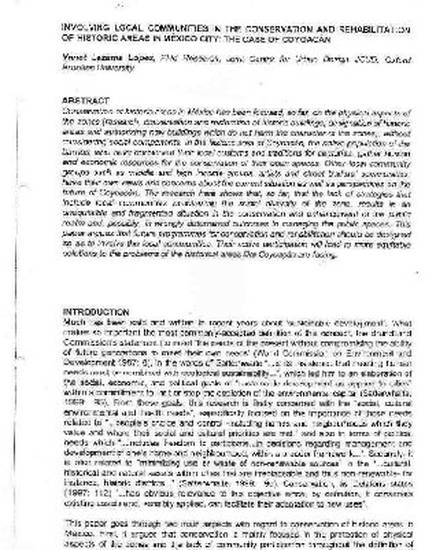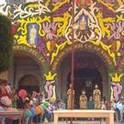
Article
Involving Local Communities in the Conservation and Rehabilitation of Historic Areas in México City: the Case of Coyoacán/Involucrando comunidades locales en la conservacion y rehabilitación de areas históricas en la Ciudad de México: el caso de Coyocán
SUSTAINABLE CITIES SUSTAINABLE DEVELOPMENT- The Urban Agenda in the Developing World 17th Interschools Conference Proceedings, Oxford 2000
(2000)
Abstract
Conservation of historic areas in México has been focused on the physical aspects of the zones, without considering their social and spatial dimensions. There is a need in México of an integrated conservation which considers the economic, cultural and social factors affecting the built environment. In the historic area of Coyoacán, the native population of the barrios, who conserve their local customs and traditions, gather human and economic resources for the conservation of their open spaces. Other local community groups such as middle and high income groups, artists and street traders’ communities, have their own views and concerns about the current situation as well as perspectives on the future of Coyoacán. The research here shows that the lack of strategies that include local communities maintaining the social diversity of the zone, results in an inequitable and fragmented situation in the conservation and enhancement of the public realm and, possibly, in wrongly determined outcomes in managing the historical built landscape. This paper argues that, by involving local community groups in all stages of urban design, planning and conservation processess, more effective solutions to the problems historic areas in Mexico are facing, can be pursued. The author also argues that any viably sustainable approach to conservation of the public realm must be constructed around concepts and practices which are shaped by participatory practices and understanding.
This paper was published in ZETTER R, and BUTINA, G. (2006)Designing Sustainable Cities in the Developing World , Aldershot, Great Britain.
La conservación de áreas históricas en México se ha limitado a los aspectos físicos sin considerar sus dimensiones sociales y espaciales. Es impostergable una conservación integrada que considere los aspectos económicos, culturales y sociales que afectan el entorno construido. En el área histórica de Coyoacán, la población nativa de sus barrios, quienes han conservado sus costumbres locales y tradiciones, reúnen recursos humanos y financieros para la conservación de sus espacios públicos. Otros grupos comunitarios, de niveles medios y altos, artistas, vendedores semi-establecidos y establecidos, tienen sus propias percepciones acerca de la situación actual, así como su visión sobre el futuro de Coyoacán. La investigación en la que se basa este capítulo del libro presenta evidencia acerca de la escasa participación de las comunidades en el manejo y en la toma de decisiones que afectan la zona, lo que ha resultado en una situación fragmentada e inequitativa en la conservación y mejora del espacio público. El documento sostiene que, involucrando a las comunidades locales en las diferentes etapas de los procesos de planeación, diseño y conservación, se pueden encontrar soluciones más equitativas y sostenibles para las problemas que enfrentan las zonas históricas como Coyoacán. La autora sostiene también que el enfoque viable y sostenible de la conservación del “public realm” (el "reino" o los espacios públicos), debiera ser construido sobre los conceptos y practicas que sean delineados con base en la teoría y prácticas participativas.
Este documento se publicó en ZETTER R, y BUTINA, G. (2006)Designing Sustainable Cities in the Developing World , Aldershot, Great Britain.
Keywords
- Historic areas conservation,
- local communities involvement,
- Mexico,
- Coyoacan,
- urban conservation
Disciplines
Publication Date
April, 2000
Citation Information
LEZAMA-LÓPEZ, Yanet (2000) “Involving Local Communities in the Conservation and Rehabilitation of Historic Areas in México City: The Case of Coyoacán”. In Sustainable Cities Sustainable Development - The Urban Agenda in the Developing World. 17 Inter-Schools Conference Proceedings”, Oxford Brookes University on 4-6 April 2000 (“Involucrando Comunidades locales en la Conservación y Rehabilitación de áreas Históricas en la Ciudad de México: el caso de Coyoacán. En Desarrollo Sostenible y Ciudades Sostenibles. La Agenda Urbana en Mundo en Vías de Desarrollo. Actas de la 17a. Conferencia Inter-Universitaria, Oxford Brookes University, 4 al 6 de abril de 2000.). Great Britain: Oxford Brookes University.
